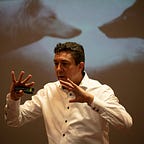To gain trust, words and body language matter
What percentage of our communication do we express non-verbally? A brief search on the internet will unearth a range of answers. It could be 70%, 80% or even 90%. Or any other random answer, depending on which manager, trainer or coach you talk to. Somewhat confusing don’t you think? But is there a right answer?
Trainers and coaches will gladly confirm that there is. And they will refer to research done by, amongst others, professor Albert Mehrabian. In 1971, he conducted a study showing that 93% of our communication is non-verbal, and therefore that just 7% is influenced by the words we use. Does this mean then that words are of little importance? That from now on we can stop learning foreign languages because we will be able to understand what the other person means just from their body language? Of course not. What has happened here is that the conclusions of his research have been quoted out of context and the general rule that has been derived from it is simply not true!
The essential question of the study performed by Mehrabian was: what do people base their trust on when they observe differences between verbal and non-verbal signals in the person they are engaged in conversation with, when the other person is talking about his feelings or his opinion concerning a specific topic? For example: if you tell your colleague that you agree with his proposal but you’re saying this with a taut mouth, talking in short sentences and mumbling, frowning and looking away, what’s the message your colleague will be picking up? Does he believe you based on the words you use, or does he form another opinion based on your non-verbal communication? Let’s take another example: you claim that you’re angry, but at the same time your eyes are shining bright, you’ve got a friendly smile on your face and you’re talking in a cheerful, relaxed voice. What message are you getting across here? Mehrabian’s study revealed that in these kinds of situations, in 7% of the cases the opinion of the listener is formed based on words, 38% on tonality (speed of speech, tone level, volume, etc.) and 55% on the facial expression.
So when you talk about your feelings and opinions, the person you talk to tends to believe you based on what they think they’re observing in your non-verbal behaviour! That’s the message from the study. This relationship can also apply in all other types of conversations, but it is not evident from the study. So this means that if you are engaged in conversation in which credibility and making a good impression are important, you should ensure that your words and your non-verbal behaviour correspond with each other. It’s interesting to note that this conclusion ties in very closely with a statement made by John Ruskin (1819–1900) a century earlier :
“The essence of lying is in deception, not in words”.
If you’d like some tips on how to find out if someone’s lying, then take a look at this short video on this topic.
I want to stress again that words still play a major role in communication (and not just 7%!). For example, if you’re giving a presentation where you’re trying to sell something, then it’s important that the spoken text expresses the content accurately. It is even claimed that in one-to-one sales talks or negotiations, words are much more important than we generally assume. The relationship is roughly: 53% verbal, 32% non-verbal and 15% tonality. Although intuitively I would agree with these figures, I haven’t yet managed to find any information to substantiate this. If you happen to have proof, I’d like to hear from you!
In summary then: based on non-verbal behaviour, it may occur that despite someone’s ‘wonderful words’, you don’t believe him. Or quite the opposite — even though someone’s story isn’t that well structured or convincing, you feel you can trust that person. That’s why it’s important to learn how to read body language. To get started, take a look at this website containing some background information and where you can do some tests to see how good you are in reading body language.
Finally: this time I’m not presenting you with a challenge. After all, you can’t work at full stretch all the time. It’s important to relax now and then. And while I’m writing these words, there’s a big smile on my face and my eyes are twinkling. Any idea what that might mean?!
Enjoy reading body language!
Drs. Marco Buschman
Eager to hear more?
Do you want to hear more about how to develop these kind of skills as a connected manager? Then listen to this podcast ‘How a culture of understanding transforms teams and organisations’. My managementbook THE CONNECTION QUOTIENT is available at your local Amazon webpage, Kindle, Kobo or Apple and at Bol.com.
